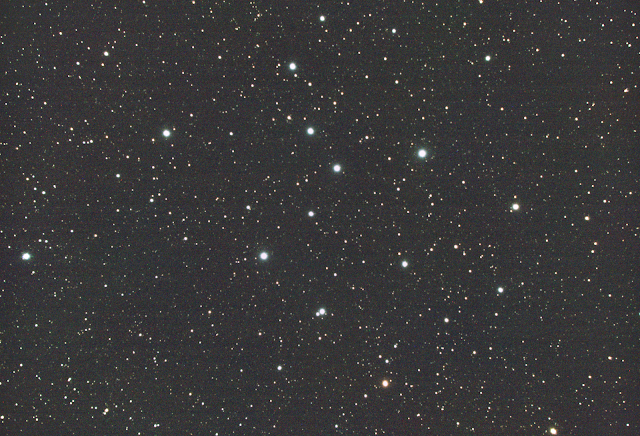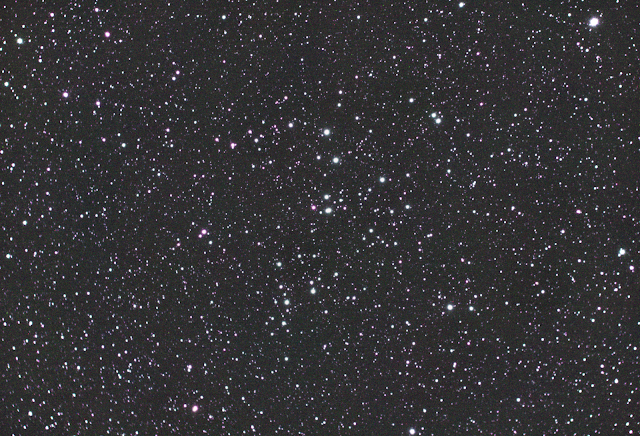 |
| CR399 |
 |
| Messier 21 |
 |
| Messier 39 |
 |
| Messier 52 |
 |
| NGC6664 |
 |
| NGC6882 |
 |
| NGC 6913 |
This blog was started to display my one shot color camera Deep Sky Images first with a Meade Deep Sky Imager then ZWO ASI174MC-COOL and now ZWO ASI294MC Pro.
 |
| CR399 |
 |
| Messier 21 |
 |
| Messier 39 |
 |
| Messier 52 |
 |
| NGC6664 |
 |
| NGC6882 |
 |
| NGC 6913 |
Comet C/2014 Q2 Lovejoy from April 2015 and accompanying open clusters were taken with the Meade DSI Color II. Quite a bit of noise is evident in these stretched images despite the use of dark frames. Not sure about exposure times. Recent an near future posted Meade DSI astro-images will be targets for future imaging with the ASI294MC Pro.
 |
| Comet C2014 Q2 Lovejoy |
 |
| Messier 41 |
 |
| M44 |
 |
| NGC1502 |
 |
| NGC1857 |
 |
| NGC2506 |
The following are a few never posted open star clusters taken with the Celestron 8/AVX and Meade DSI back on 1/14/2016. Lacking notes I have estimated the fields of view based on ratios of measured object radius and image width. The average FOV was 32x26 arcmin corresponding to F/3.3 indicating inline use of the Celestron F/6.3 and Atik 0.5x focal reducers. Images were made before acquiring an auto-guider and thus are unguided. The AVX mount's all star polar alignment combined with relatively short exposures yielded nice round star images.
 |
| Messier 103 |
 |
| NGC 1647 |
 |
| NGC 1807 |
 |
| NGC 1817 |
 |
| NGC 2129 |
 |
| NGC 2158 |
I don't usually image planets on the same night as imaging deep sky objects because they involve very different optical configurations. On this particular night, 10/17/2020, after imaging Sharpless-106 (Butterfly Nebula), IC1396(Elephant Trunk Nebula) and NGC7293 (Helix Nebula) the corrector lens on the Celestron 8 was just starting to fog.
This shortened the night with Mars high up to the east. I decided to reconfigure the scope and image Mars. Typical of Massachusetts seeing was mediocre. With better seeing I think Mars could be sharper. OTOH I am using a one shot color camera which, compared to a monochrome camera with color filters, is suboptimal. It's a compromise I live with for time efficiency.
DSO images were acquired at F/4 coupling the Starizona Night Owl focal reducer, Orion SkyGlow Imaging Filter and ASI294MC Pro one shot color camera.
I also could have done better centering IC 1396; which I missed the last night out. I should try to image Sh-106 on a night when imaging smaller targets such as planetary nebulae. Sadly, NGC7293 is in an increasingly light polluted part of the sky to the south of Harvard, MA. Of note, I stack and average images using Autostakkert! I then post process with PaintShop Pro 2021 to which I will devote a future posting.
UPDATE: After watching Robin Glover's Astrophotography with CMOS Cameras video on effective use of signal/noise, the three DSOs will be reimaged using 30s or 60s subs for my typical skies.
 |
| NGC7293(Helix Nebula) 6 x 300s, F/4, ASI294MC Pro |
 |
| IC1396 (Elephant Trunk Nebula) 6 x 300s, F/4, ASI 294MC Pro |
 |
| Sharpless 106 (Butterfly Nebula) 10 x 120s, F/4, ASI294MC Pro, |
 |
| Mars, 2x Barlow (~F/20), ASI178MC, 1078x768 |
Tuesday night promised to be mostly clear and calm with rising humidity. With the likely suboptimal transparency, subpar seeing and night shortening fogging due to humidity the focus would be on open clusters. The first two targets IC4665 and IC4756 were acquired with 12x15s exposures. The remaining were sets of 12x30s exposure subframes. With the nights calm winds and previous AVX mount gear adustments guiding went very well. By 11 PM the Celestron 8 corrector plate was starting to fog up signaling the end of the session. The 11 images acquired appear below. Update: These images were reprocessed in April 2023 using the free GraXpert gradient elimination app.
 |
| IC1665 |
 |
| Messier 52 |
 |
| NGC457 |
 |
| NGC869 |
 |
| NGC884 |
 |
| NGC957 |
 |
| NGC6633 |
 |
| NGC6871 |
 |
| NGC6883 |
 |
| NGC7039 |
 |
| NGC7082 |
 |
| NGC7243 |
On 10/8 I travelled to Harvard, MA on a hunch the gusty winds would die down and clouds clear by the time I started imaging. Astronomical twilight was just after 8 PM. By that time it was still breezy but not gusty prompting me to leave the dew cap off to eliminate its 'sail' effect. While this reduced wind's effect it also allowed some late evening dew to form and stray light pollution from passing cars.
Targets included IC1396 which I actually missed 😕, IC5146, M13, NGC6888, NGC7293 (Helix Nebula) and Sharpless 155. NGC7293 was plagued by apparent light pollution in its low southern location. Of the listed targets only IC5146, M13, NGC6888 and Sharpless 155 are worth showing below. NGC 6888 continues to be a tough target for me even with 300s exposures and directly overhead. At only 120s exposures NGC 5146 and Sharpless 155 were surprisingly accessible. I might try 300s exposures on Sharpless 155 in the future to bring out more nebulosity.
UPDATE: I now know that it's better to acquire a bunch of 30s to 60s exposures for the equivalent time of 120s to 300s exposures.
 |
| M13 |
 |
| NGC 5146 |
 |
| NGC 6888 (Crescent Nebula) |
 |
| Sharpless 155 |
Recently, thanks to YouTube tutorial, I adjusted the AVX mount gears to reduce the large amount of RA backlash. I also made a few PHD2 settings adjustments. I had been using the recommended 1.5 to 3s guide camera exposures. I reduced that to 1.0s and reduced the RA aggressiveness to an experimental 50%. These changes have resulted in an improvement in guiding as evidenced by rounder stars and a less noisy guiding graph. The images below were acquired over two days of imaging.
 |
| NGC 6960 (Eastern Veil Nebula) |
 |
| NGC 6992 (Western Veil Nebula) |
 |
| NGC 7635 (Bubble Nebula) |
 |
| Sharpless 125 (Cocoon Nebula) |
 |
| NGC 281 (Pacman Nebula) |
Thursday 8/20/2020 promised to be clear night with average seeing according to Clearsky Charts and NOAA. I decided to head for the Harvard library darksite with the goal of imaging the Crescent, the Eastern and Western Veil nebulae using the Starizona Night Owl gambling on 120s sub frames at f/4. That proved a mistake. The results were under exposed and noisy. I won't bother posting the images here. In the future I will try imaging with 300s sub frames that yielded better results at a higher f/6.4 focal ratio in the past.
Fortunately, I also imaged Comet Neowise, M8, M16, M17, M20 and M13 on the same night. Sub frames were acquired with 30s exposures at a gain of 120. The images appear below. The images are pretty okay but could be better. The auto-guider was quite erratic along the RA axis resulting in elongated stars. With the waxing moon I will focus on debugging this issue locally starting with running the PHD2 setup wizard.
On a different note flat frames captured during twilight were at the wrong focus making them useless. I decided to keep the optical assembly together and collect a set of flat frames at home next day. The first set, taken from a lamp illuminated wall looked good but yielded ugly images marred with gradients. At first I assumed the problem was camera settings and light pollution. On a whim I tried using a white jpeg image on my LED HDTV screen as a flat frame target. It worked resulting in the images below. 😊
 |
| Comet C/2020 F3 Neowise |
 |
| M8 (Lagoon Nebula) |
 |
| M16 (Eagle Nebula) |
 |
| M17 (Omega Nebula) |
 |
| M13 (Hercules Cluster) |
 |
| M20 (Trifid Nebula) |